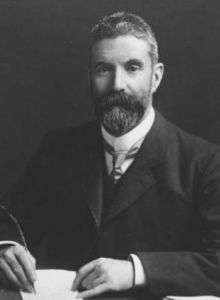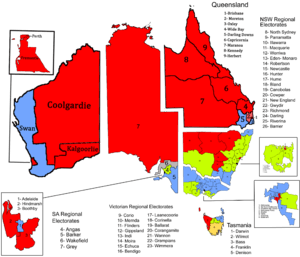Australian federal election, 1903
| | |||||||||||||||||||||||||||||||||||||||||||||||||||||||||||
| |||||||||||||||||||||||||||||||||||||||||||||||||||||||||||
| |||||||||||||||||||||||||||||||||||||||||||||||||||||||||||
|
| |||||||||||||||||||||||||||||||||||||||||||||||||||||||||||
| |||||||||||||||||||||||||||||||||||||||||||||||||||||||||||
Federal elections were held in Australia on 16 December 1903. All 75 seats in the House of Representatives, and 19 of the 36 seats in the Senate were up for election. The incumbent Protectionist Party minority government led by Prime Minister of Australia Alfred Deakin retained the most House of Representatives seats of the three parties and retained government with the parliamentary support of the Labour Party led by Chris Watson, while the Free Trade Party led by George Reid remained in opposition.
The election outcome saw a finely balanced House of Representatives, with the three parties each holding around a third of seats − the Protectionists on 26 (−5), the Free Traders on 24 (−4) and Labour on 22 (+7). This term of parliament saw no changes in any party leadership but did see very significant and prolonged debates on contentious issues − the Protectionist minority government fell in April 1904 to Labour, while the Labour minority government fell in August 1904 to the Free Traders, while the Free Trader minority government fell in July 1905 back to the Protectionists, which continued until the 1906 election and beyond. The Free Traders remained in opposition throughout this eventful period with the exception of Labour forming the opposition for the first time during the period of the Free Trader minority government. Additionally, the Watson government was the world's first Labour Party government at a national level.
Results
| Party | Votes | % | Swing | Seats | Change | Notes | |
|---|---|---|---|---|---|---|---|
| Free Trade Party | 247,774 | 34.37 | +4.33 | 24 | −4 | (4 elected unopposed) | |
| Federal Labour Party | 223,163 | 30.95 | +15.20 | 22 | +7 | (2 elected unopposed) | |
| Protectionist Party | 214,091 | 29.70 | −7.05 | 26 | −5 | (11 elected unopposed) | |
| Revenue Tariff Party | 3,546 | 0.49 | * | 1 | +1 | ||
| Independents/Other | 32,364 | 4.49 | 2 | 0 | |||
| Total | 720,938 | 75 | |||||
| Protectionist/Labour | WIN | 48 | +3 | ||||
| Free Trade Party | 24 | −4 | |||||
Independent: Frederick Holder (Wakefield, SA), James Wilkinson (Moreton, Qld)
| Party | Votes | % | Swing | Seats Won | Seats Held | Change | |
|---|---|---|---|---|---|---|---|
| Free Trade Party | 986,030 | 34.33 | −5.11 | 4 | 12 | −5 | |
| Federal Labour Party | 854,628 | 29.76 | +16.25 | 10 | 14 | +6 | |
| Protectionist Party | 503,586 | 17.53 | −27.33 | 3 | 8 | −3 | |
| Liberal Party (Qld) | 136,727 | 4.76 | * | 0 | 0 | ||
| Revenue Tariff Party | 25,310 | 0.88 | * | 1 | 1 | +1 | |
| Independent | 365,851 | 12.74 | 1 | 1 | +1 | ||
| Total | 2,872,132 | 19 | 36 | ||||
Independent: William Trenwith (Vic)
Significance
The election saw the Labour party make significant gains outside New South Wales and Victoria. As a result of Labour's gains, the numbers of the three parties in Parliament were very close to equal, leading to unstable governments. Alfred Deakin would describe it as a parliament of "three elevens" (three cricket teams). Although the Protectionists were able to retain their minority government with the qualified support of the Labour Party, the equal numbers would see a record three changes of government over the course of the Parliamentary term, with each of the three parties holding office at least once during the term of the Parliament.
The three parties that contested the 1901 election also contested the 1903 election, with only the Protectionists changing leaders to Alfred Deakin as a result of Edmund Barton's appointment as an inaugural judge of the newly constituted High Court of Australia. The Free Trade Party was again led by George Reid. The only significant difference in policy between these parties was on trade issues. The Protectionists sought to protect Australian industry and agriculture by placing tariffs on imports. The Free Traders downgraded the view they had last election of having no tariffs to campaigning on minimal tariffs. The other major party contesting the election was the Labour Party.
This election also saw a minor party, the Tasmanian Revenue Tariff Party gain an MHR and one Senator. Prior to the 1901 election, the Free Trade Party had been known as the Revenue Tariff Party in some states. However, in 1903 a separate Revenue Tariff Party competed against the FTP in Tasmania. Nevertheless, both of the Revenue Tariff Party members elected joined the Free Trade Party, when the new parliament began sitting.
Women were given the vote in all states, following the Commonwealth Franchise Act 1902, leading to a significant increase in the number of votes cast in the 1903 election. Like the 1901 election, voting was voluntary and candidates were elected by the First-past-the-post system.
Electorates
Candidates were contesting all 75 House of Representatives and 19 of the 36 Senate seats, a number unchanged from the 1901 election. The House of Representative seats were determined by the population of each state, giving 26 seats to New South Wales, 23 to Victoria, nine to Queensland, seven to South Australia and five to both Western Australia and Tasmania. In 1901, the South Australian and Tasmanian colonial parliaments had not legislated for single member electorates, so their House of Representative members were elected from a single statewide electorate. This had since changed and there were now single member electorates in both states. The newly created seats were Adelaide, Angas, Barker, Boothby, Grey, Hindmarsh and Wakefield (South Australia) and Bass, Darwin, Denison, Franklin and Wilmot (Tasmania).
Each state elected six Senators regardless of population. The Senate was elected by bloc voting rather than the current single transferable vote system. Half the Senators retired as their terms expired, and there was one casual vacancy.
Seats changing hands
| Seat | Pre-1903 | Swing | Post-1903 | ||||||
|---|---|---|---|---|---|---|---|---|---|
| Party | Member | Margin | Margin | Member | Party | ||||
| Adelaide, SA | new division | 100.0 | Charles Kingston | Protectionist | |||||
| Angas, SA | new division | 100.0 | Paddy Glynn | Free Trade | |||||
| Barker, SA | new division | 100.0 | Langdon Bonython | Protectionist | |||||
| Bass, Tas | new division | 6.7 | David Storrer | Protectionist | |||||
| Boothby, SA | new division | 100.0 | Lee Batchelor | Labour | |||||
| Brisbane, Qld | Protectionist | Thomas Macdonald-Paterson | 7.6 | 9.7 | 2.1 | Millice Culpin | Labour | ||
| Capricornia, Qld | Independent | Alexander Paterson | 1.0 | 8.6 | 9.6 | David Thomson | Labour | ||
| Corangamite, VIC | Protectionist | Chester Manifold | 22.2 | 35.2 | 2.2 | Gratton Wilson | Free Trade | ||
| Cowper, NSW | Protectionist | Francis Clarke | 2.4 | 15.4 | 13.0 | Henry Lee | Free Trade | ||
| Darwin, Tas | new division | 0.7 | King O'Malley | Labour | |||||
| Denison, Tas | new division | 0.2 | Philip Fysh | Protectionist | |||||
| Franklin, Tas | new division | 4.6 | William McWilliams | Revenue Tariff | |||||
| Fremantle, WA | Free Trade | Elias Solomon | 10.3 | 21.6 | 11.3 | William Carpenter | Labour | ||
| Grey, SA | new division | 100.0 | Alexander Poynton | Free Trade | |||||
| Gwydir, NSW | Protectionist | George Cruickshank | 12,9 | 24.3 | 11.4 | William Webster | Labour | ||
| Hindmarsh, SA | new division | 16.7 | James Hutchison | Labour | |||||
| Hunter, NSW | Protectionist | Edmund Barton | 100.0 | 59.3 | 13.3 | Frank Liddell | Free Trade | ||
| Kalgoorlie, WA | Free Trade | John Kirwan | 14.1 | 30.7 | 26.6 | Charles Frazer | Labour | ||
| New England, NSW | Protectionist | William Sawers | 0.6 | 2.5 | 1.9 | Edmund Lonsdale | Free Trade | ||
| Riverina, NSW | Protectionist | John Chanter | 3.5 | 3.5 | 0.0 | Robert Blackwood | Free Trade | ||
| Wakefield, SA | new division | 100.0 | Frederick Holder | Independent | |||||
| Wilmot, Tas | new division | 4.9 | Edward Braddon | Free Trade | |||||
- Members in italics did not contest their seat at this election.
Post-election pendulum
See also
- Candidates of the Australian federal election, 1903
- Members of the Australian House of Representatives, 1903–1906
- Members of the Australian Senate, 1904–1906
- First Deakin Government
Notes
References
- State and federal election results in Australia since 1890



